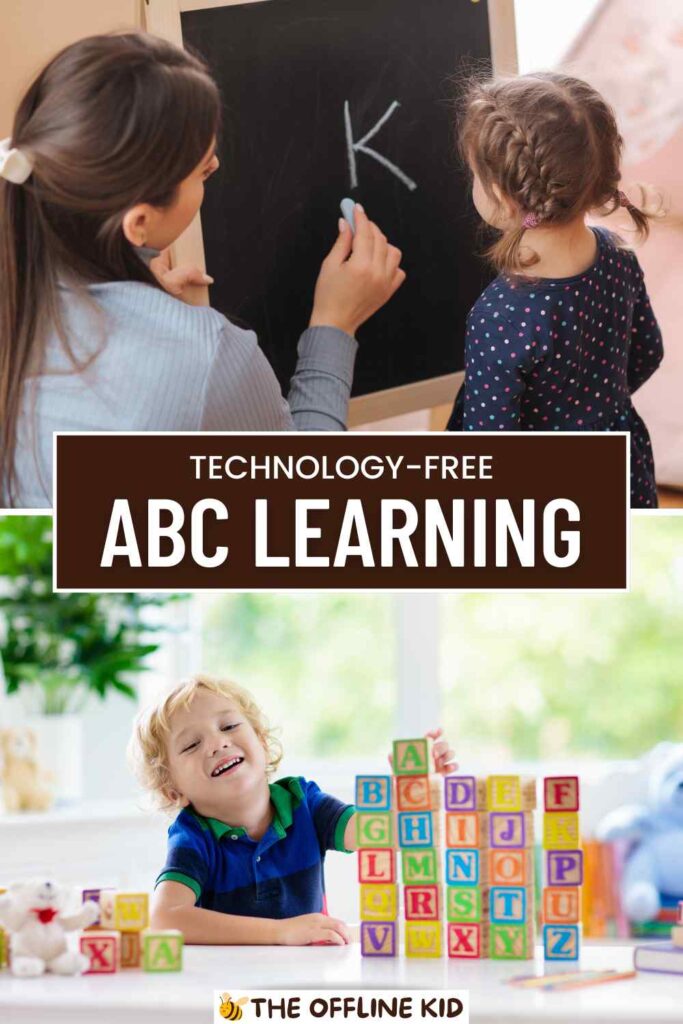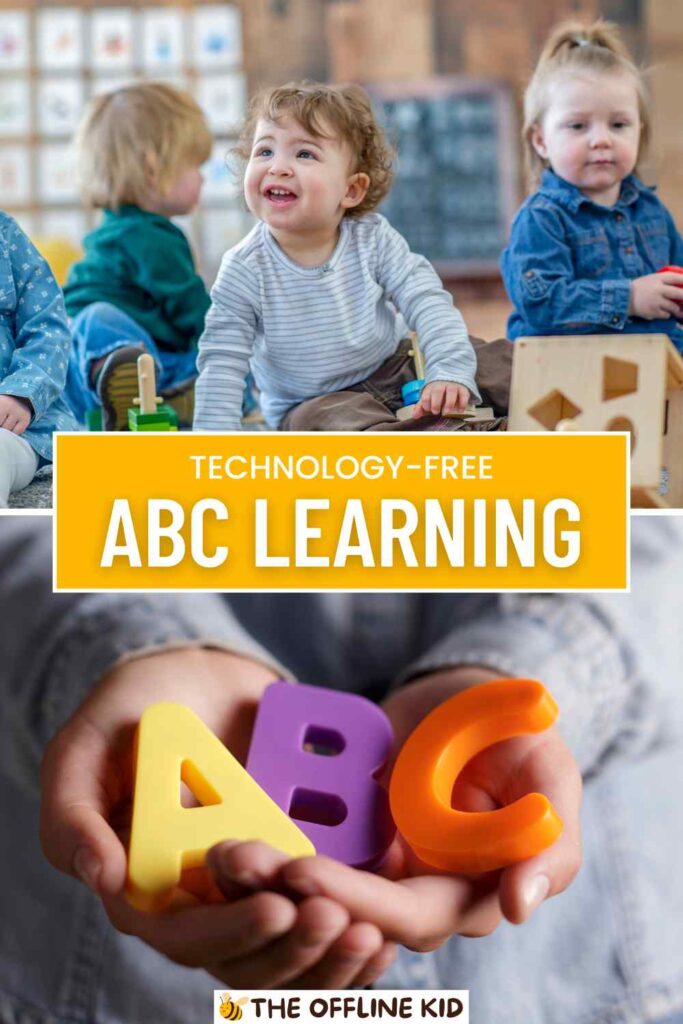Teaching the ABCs to kids can be fun and effective without relying on technology.
This guide provides creative, hands-on methods to help children learn their letters in engaging and enjoyable ways.
From traditional flashcards to interactive games and everyday activities, you’ll discover a variety of techniques to foster a love for learning the alphabet.
Traditional Teaching Methods
Flashcards
Flashcards are a tried-and-true method for teaching the ABCs. They are simple, versatile, and can be used in many fun ways.
Benefits of Using Flashcards:
- Visual Learning: Flashcards help kids associate letters with their shapes.
- Repetition: Frequent use reinforces memory.
- Flexibility: Easy to carry and use anywhere.
How to Make and Use Homemade Flashcards:
- Materials Needed: Index cards, markers, stickers, and magazine cutouts.
- Steps:
- Write one letter per card, using uppercase on one side and lowercase on the other.
- Decorate with stickers or pictures representing objects that start with that letter.
- Laminate for durability (optional).
Fun Flashcard Games and Activities:
- Memory Match: Place cards face down and have children match uppercase and lowercase pairs.
- Flashcard Hunt: Hide cards around the house and let kids find and identify them.
- Alphabet Order: Mix up the cards and ask kids to arrange them in alphabetical order.
Alphabet Books
Alphabet books are a wonderful way to immerse children in the world of letters through stories and illustrations.
Recommended Alphabet Books for Different Age Groups:
- Toddlers: “A is for Apple” by Georgie Birkett
- Preschoolers: “Chicka Chicka Boom Boom” by Bill Martin Jr. and John Archambault
- Early Readers: “Dr. Seuss’s ABC” by Dr. Seuss
How to Read and Engage with Alphabet Books:
- Interactive Reading: Ask questions about the pictures and letters.
- Letter Sounds: Emphasize the sounds each letter makes.
- Repetition: Read frequently to reinforce learning.
Creating Personalized Alphabet Books with Kids:
- Materials Needed: Blank book or notebook, markers, stickers, family photos.
- Steps:
- Dedicate a page for each letter.
- Include drawings or photos of family members, pets, or favorite objects that start with each letter.
- Write short, simple sentences using those words.
Singing the Alphabet Song
Music is a powerful tool for learning, and the alphabet song is a classic example.
The Power of Music in Learning:
- Memory Aid: Melodies make it easier to remember sequences.
- Engagement: Singing is enjoyable and keeps kids’ attention.
- Language Development: Helps with pronunciation and rhythm.
Different Versions of the Alphabet Song:
- Traditional Version: The classic “A-B-C-D” tune.
- Modern Variations: Songs like “The Alphabet Song” by Sesame Street.
- Interactive Versions: Songs with actions or dance moves.
Incorporating Movement and Actions into the Song:
- Alphabet Dance: Create simple dance moves for each letter.
- Sign Language: Teach the American Sign Language (ASL) alphabet along with the song.
- Clap and Stomp: Clap hands or stomp feet to the rhythm of the song, emphasizing each letter.
By using these traditional teaching methods, you can create a solid foundation for your child’s alphabet learning journey. Flashcards, alphabet books, and songs are not only effective but also fun ways to engage young learners.
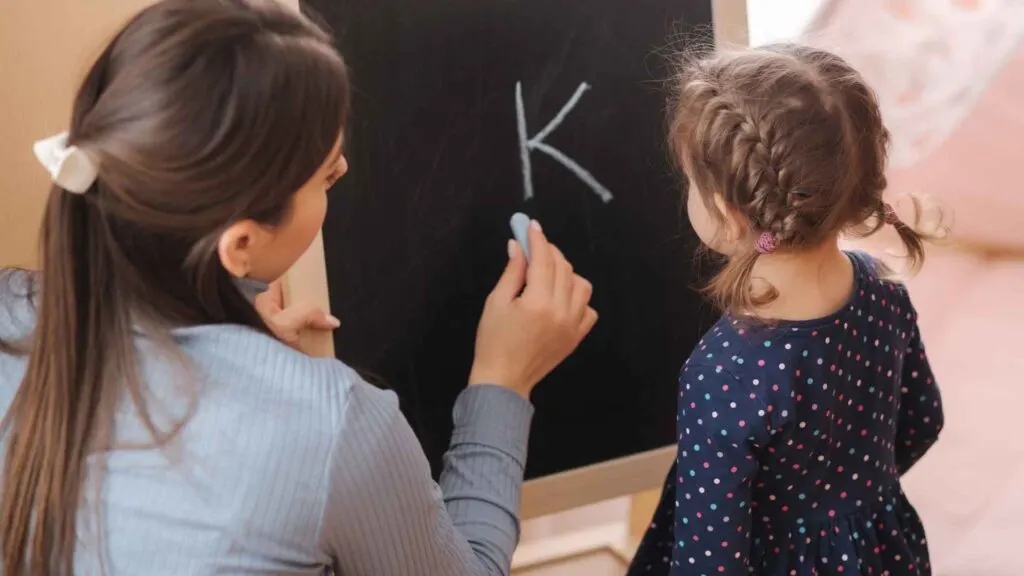
Hands-On Activities
Alphabet Crafts
Crafting is a fantastic way to combine creativity with learning. Engaging in crafts helps children reinforce letter recognition and sounds while having fun.
Craft Ideas for Each Letter of the Alphabet:
- A for Apple: Create apple prints using real apples dipped in paint.
- B for Butterfly: Make butterflies with coffee filters and clothespins.
- C for Caterpillar: Use pom-poms and pipe cleaners to make a caterpillar.
Using Everyday Materials for Alphabet Crafts:
- Recycled Materials: Use bottle caps, cardboard, and old magazines for craft projects.
- Nature Items: Incorporate leaves, twigs, and flowers into letter crafts.
- Household Items: Utilize cotton balls, pasta, and buttons for creating letters.
Integrating Crafts into Daily Routines:
- Themed Days: Dedicate a day of the week to crafting a new letter.
- Storytime Crafts: Pair a craft with a book that highlights the letter of the day.
- Display Art: Create an alphabet wall with completed crafts to showcase progress.
Letter Tracing and Writing
Writing and tracing letters help children develop fine motor skills and reinforce letter recognition.
Benefits of Tracing and Writing Practice:
- Motor Skills: Improves hand-eye coordination and muscle memory.
- Letter Formation: Helps children learn the correct way to form each letter.
- Confidence: Builds self-assurance as children master writing.
Fun and Creative Ways to Trace and Write Letters:
- Sand Tracing: Fill a tray with sand and let kids trace letters with their fingers.
- Finger Paint: Use finger paints to write letters on paper.
- Chalk on Sidewalks: Draw large letters on the sidewalk and let children trace them.
Using Different Mediums:
- Sand: Encourage kids to write letters in a sand tray or sandbox.
- Finger Paint: Allow them to use finger paints to trace or write letters on paper.
- Chalk: Draw large letters on sidewalks or chalkboards for tracing practice.
Alphabet Puzzles and Blocks
Puzzles and blocks are excellent tools for hands-on learning, promoting both cognitive and motor skills development.
Educational Benefits of Puzzles and Blocks:
- Problem-Solving: Enhances critical thinking and problem-solving skills.
- Spatial Awareness: Improves understanding of shapes and spatial relationships.
- Fine Motor Skills: Develops hand strength and coordination.
Ideas for DIY Alphabet Puzzles and Blocks:
- Puzzle Pieces: Create puzzle pieces from cardboard with letters that fit together.
- Building Blocks: Paint or write letters on wooden blocks for stacking and arranging.
- Match Games: Make a matching game with letters and corresponding pictures.
Engaging Games Using Puzzles and Blocks:
- Name Building: Use letter blocks to spell out names and simple words.
- Alphabet Towers: Build towers with blocks, placing them in alphabetical order.
- Letter Hunt: Hide blocks or puzzle pieces around the room and have kids find and arrange them.
Hands-on activities like crafts, tracing, and puzzles provide interactive and engaging ways to teach the ABCs. These methods encourage creativity, fine motor skills, and problem-solving, making learning the alphabet a fun and dynamic experience for children.
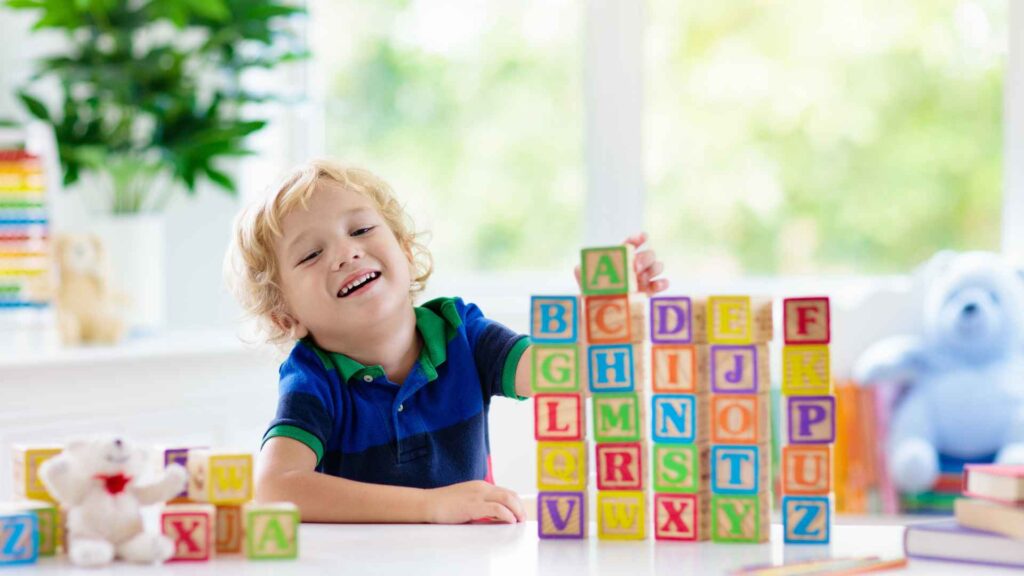
Play-Based Learning
Scavenger Hunts
Scavenger hunts are a playful way to incorporate alphabet learning into a child’s daily routine. They combine physical activity with cognitive skills, making learning fun and engaging.
Creating Alphabet Scavenger Hunts at Home or Outside:
- Home Hunts: Hide alphabet cards or objects that start with each letter around the house.
- Outdoor Hunts: Take the scavenger hunt to the park or backyard, looking for natural items that start with different letters.
- Printable Checklists: Create or download checklists that kids can mark off as they find each item.
Ideas for Themed Scavenger Hunts:
- Color-Themed Hunts: Focus on finding items of specific colors that correspond to letters (e.g., Red Apple for ‘A’).
- Animal Hunts: Search for animals or animal toys representing each letter (e.g., Butterfly for ‘B’).
- Seasonal Hunts: Tailor scavenger hunts to different seasons, finding items like snowflakes for ‘S’ in winter or flowers for ‘F’ in spring.
Tips for Making Scavenger Hunts Fun and Educational:
- Rewards: Offer small rewards or praise for completing the hunt.
- Teamwork: Encourage children to work together in groups or pairs.
- Follow-Up Activities: Discuss and draw the items found during the scavenger hunt.
Alphabet Games
Games are a fantastic way to make learning interactive and enjoyable. They can be tailored to suit various learning styles and preferences.
Classic and New Alphabet Games:
- Alphabet Bingo: Create bingo cards with letters instead of numbers. Call out letters and have kids mark their cards.
- Letter Hopscotch: Draw a hopscotch grid with letters instead of numbers. Kids jump to the letter called out.
- Alphabet Fishing: Attach magnets to paper fish with letters and use a magnetic fishing rod to “catch” them.
Instructions for Homemade Games:
- Memory Match Game: Create pairs of cards with matching uppercase and lowercase letters. Place them face down and have kids match pairs.
- Alphabet Twister: Modify the classic Twister game by adding letters to the colored circles. Call out a letter and a color for kids to place their hands or feet.
- Alphabet Ball: Write letters on a beach ball. Toss the ball around, and when a child catches it, they have to say a word starting with the letter closest to their right thumb.
How to Involve the Whole Family:
- Family Game Night: Dedicate one night a week to playing alphabet games together.
- Siblings as Teachers: Older siblings can help teach younger ones through games.
- Parental Participation: Parents can model enthusiasm and participation, making the games more enjoyable for everyone.
Role-Playing and Storytelling
Role-playing and storytelling are powerful tools for developing language skills and fostering creativity. They also offer a natural context for learning the alphabet.
Encouraging Creativity Through Role-Playing:
- Alphabet Theater: Set up a mini theater where kids can act out stories involving different letters.
- Dress-Up Games: Use costumes and props to create characters that represent different letters.
- Puppet Shows: Make or use puppets to tell stories featuring alphabet characters.
Incorporating Alphabet Learning into Storytelling:
- Letter of the Day Stories: Create a daily story centered around the “letter of the day.”
- Interactive Storytime: Pause during reading to ask questions and encourage kids to predict what happens next.
- Alphabet Adventures: Invent adventures where characters encounter various letters and objects that start with those letters.
Creating Stories Together Featuring Different Letters:
- Story Starters: Provide a sentence or two to get the story started, featuring a specific letter (e.g., “Once upon a time, a brave cat named Cora…”).
- Round Robin Storytelling: Take turns adding sentences to a story, each featuring the next letter of the alphabet.
- Illustrated Stories: Have children draw pictures to accompany the stories they create, reinforcing letter recognition and creativity.
Play-based learning methods like scavenger hunts, games, and storytelling make learning the alphabet an exciting adventure. These activities harness children’s natural curiosity and energy, turning education into a joyful experience.
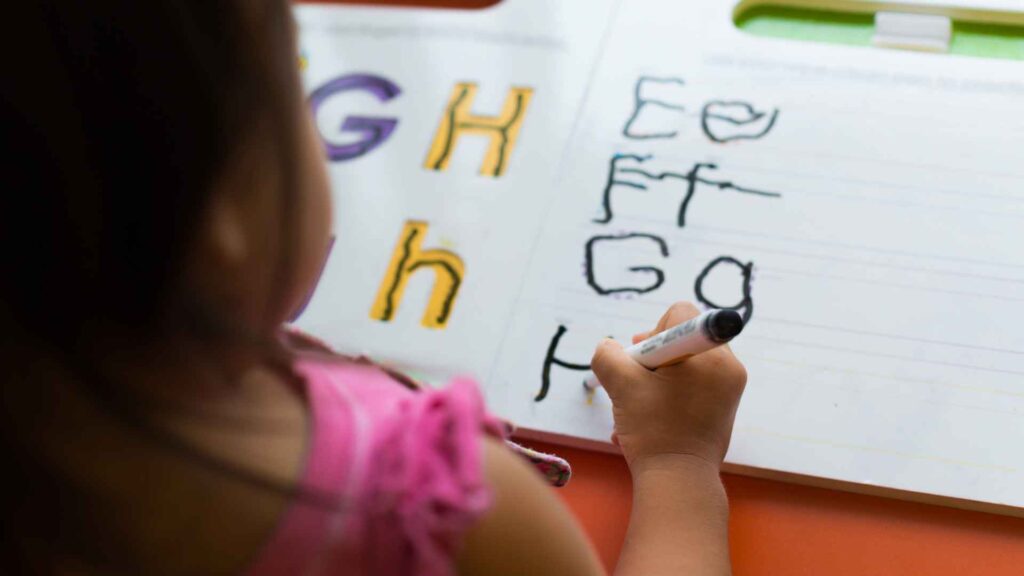
Everyday Learning Opportunities
Labeling Items Around the House
Labeling household items is a simple yet effective way to integrate alphabet learning into everyday life. This method reinforces letter recognition and vocabulary.
How to Label Items to Reinforce Learning:
- Sticky Notes: Use colorful sticky notes to label common items (e.g., ‘R’ for refrigerator, ‘T’ for table).
- Index Cards: Write the names of objects on index cards and tape them to the corresponding items.
- Picture Labels: Include pictures on labels to help younger children make connections between letters and objects.
Making it a Fun and Interactive Activity:
- Label Hunt: Have kids help place labels around the house, turning it into a game.
- Label Rotation: Change labels periodically to keep the activity fresh and engaging.
- Label Crafting: Involve children in creating the labels, allowing them to decorate and personalize them.
Rotating Labels to Keep it Interesting:
- Weekly Themes: Change labels based on weekly themes (e.g., kitchen items one week, toys the next).
- Seasonal Labels: Adjust labels to reflect different seasons or holidays.
- Challenge Labels: Add new words or more complex labels as children progress.
Grocery Shopping and Cooking
Grocery shopping and cooking offer practical opportunities for alphabet learning through real-life experiences.
Using Grocery Lists for Alphabet Learning:
- Alphabetized Lists: Create grocery lists where items are listed in alphabetical order.
- Letter of the Day: Focus on finding items that start with the letter of the day during shopping trips.
- Picture Lists: For younger children, use picture lists that correspond to alphabet letters.
Cooking Activities that Incorporate Letters:
- Alphabet Soup: Make soup with alphabet pasta and have kids identify letters in their bowls.
- Letter Cookies: Bake cookies in the shapes of different letters, decorating them together.
- Ingredient Identification: Let children help read ingredient labels and identify letters on packaging.
Fun Alphabet-Themed Snacks and Meals:
- Fruit and Veggie Letters: Arrange fruits and vegetables into the shapes of letters.
- Letter Sandwiches: Use cookie cutters to make sandwiches in the shapes of letters.
- Alphabet Smoothies: Name smoothies after letters and ingredients (e.g., “B-Berry Blast” for blueberries and bananas).
Nature Walks and Outdoor Activities
Outdoor activities provide a dynamic environment for learning the alphabet, combining physical activity with educational exploration.
Finding Letters in Nature:
- Alphabet Shapes: Look for natural items that resemble letter shapes (e.g., a curved stick for ‘C’).
- Nature Rubbings: Use paper and crayons to make rubbings of textured items like leaves or tree bark in the shapes of letters.
- Alphabet Rocks: Paint or draw letters on rocks and hide them for a nature hunt.
Creating Nature-Inspired Alphabet Activities:
- Alphabet Garden: Plant flowers or vegetables with names starting with each letter of the alphabet.
- Nature Collage: Collect items from nature to create a collage, labeling each item with its starting letter.
- Letter Trails: Use sticks or stones to form letters on the ground, creating trails for kids to follow.
Outdoor Games that Teach the ABCs:
- Alphabet Relay: Set up a relay race where children collect items that start with specific letters.
- Letter Hop: Write letters on the sidewalk or driveway with chalk and have kids hop from letter to letter, saying the letter names aloud.
- Scavenger Hunt: Combine nature walks with alphabet scavenger hunts, looking for items that start with each letter.
By leveraging everyday activities like labeling, grocery shopping, and nature walks, you can seamlessly integrate alphabet learning into daily routines. These methods make learning the ABCs a natural and enjoyable part of life, reinforcing knowledge through consistent, real-world practice.
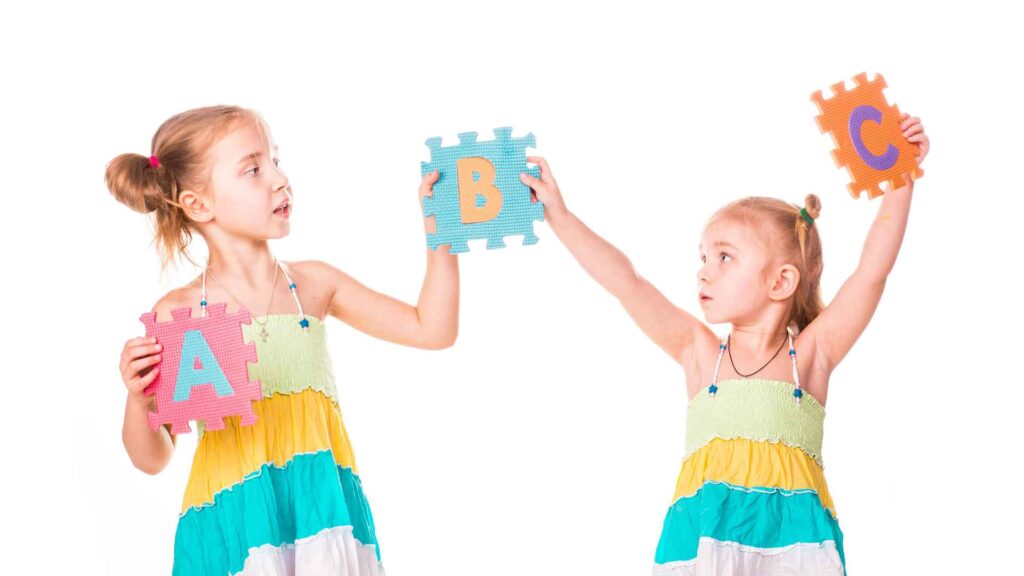
Involving Others in the Learning Process
Sibling and Peer Learning
Learning alongside siblings and peers can enhance a child’s educational experience by adding an element of fun and camaraderie. It encourages social interaction and collaborative learning.
Encouraging Older Siblings to Teach Younger Ones:
- Teaching Roles: Assign older siblings the role of a “teacher” to help their younger siblings learn the alphabet.
- Shared Activities: Plan joint activities where both can participate, such as reading alphabet books together or playing alphabet games.
- Positive Reinforcement: Praise older siblings for their teaching efforts, fostering a sense of responsibility and accomplishment.
Group Activities for Friends and Neighbors:
- Alphabet Playdates: Organize playdates with alphabet-themed games and crafts.
- Letter Parties: Host small gatherings where children engage in alphabet scavenger hunts, storytime, and snack-making activities.
- Collaborative Projects: Encourage kids to work on projects like making an alphabet mural or creating a group alphabet book.
Creating a Supportive Learning Environment:
- Inclusive Activities: Design activities that cater to different age groups and learning paces.
- Peer Encouragement: Foster a supportive atmosphere where children cheer each other on.
- Shared Successes: Celebrate milestones and achievements together, such as completing an alphabet chart or mastering tricky letters.
Grandparents and Family Members
Involving grandparents and other family members in the learning process can provide additional support and create special bonding moments.
Ideas for Family Members to Get Involved:
- Alphabet Storytelling: Have grandparents share stories or read alphabet books with the children.
- Letter Writing: Encourage family members to write letters to the children, emphasizing different letters of the alphabet.
- Crafting Together: Plan craft sessions where grandparents and kids make alphabet-themed projects together.
Activities That Can Be Done During Visits or Virtually:
- Alphabet Video Calls: Organize virtual storytimes or alphabet games with family members who live far away.
- Letter Exchange: Set up a pen-pal system where children exchange letters with relatives, practicing their writing and recognition skills.
- Shared Projects: Collaborate on projects like an alphabet quilt or scrapbook, with each family member contributing a piece.
Sharing Progress and Celebrating Milestones Together:
- Photo Updates: Send pictures or videos of the child’s progress to family members.
- Celebration Events: Hold small parties or virtual gatherings to celebrate significant achievements, like learning all the letters.
- Family Recognition: Create certificates or awards to recognize the child’s hard work and progress, presented by family members.
By involving siblings, peers, and other family members in the alphabet learning process, children receive additional encouragement and support. These interactions make learning more enjoyable and memorable, fostering a collaborative and nurturing educational environment.
Tips for Success
Keeping it Fun and Stress-Free
Making the learning process enjoyable and relaxed is key to maintaining a child’s interest and enthusiasm.
Avoiding Pressure and Keeping Learning Enjoyable:
- Child-Led Learning: Allow children to guide the pace and activities, ensuring they feel comfortable and interested.
- Flexible Schedules: Incorporate alphabet learning into everyday routines without strict schedules.
- Variety of Activities: Rotate between different activities to keep things fresh and exciting.
Balancing Structured Activities with Free Play:
- Combination Approach: Mix structured activities like flashcards and tracing with free play that naturally incorporates letters.
- Creative Play: Encourage children to explore letters through play, such as building with alphabet blocks or creating letter shapes with playdough.
- Observation: Allow time for free play and observe how children incorporate what they’ve learned, reinforcing their understanding.
Recognizing and Celebrating Small Achievements:
- Positive Reinforcement: Praise and celebrate every small step and success to boost confidence.
- Reward Systems: Use simple reward systems like sticker charts to mark progress.
- Celebratory Moments: Create mini-celebrations for milestones, such as learning a new letter or completing an activity.
Consistency and Routine
Establishing a regular learning routine helps children develop a habit and creates a sense of security and expectation around learning times.
Establishing a Regular Learning Schedule:
- Daily Practice: Incorporate a few minutes of alphabet learning into daily routines, such as during breakfast or bedtime.
- Consistent Times: Choose specific times of day for learning activities to build consistency.
- Routine Integration: Blend alphabet activities into regular routines, like singing the alphabet song during bath time.
Integrating Alphabet Activities into Daily Routines:
- Morning Routines: Start the day with a quick alphabet activity or song.
- Meal Times: Discuss letters and words related to meals and ingredients.
- Bedtime Stories: Read alphabet books or tell stories that feature letters prominently.
Being Flexible and Adapting to Your Child’s Needs:
- Individual Pacing: Adapt activities to suit your child’s learning pace and interests.
- Responsive Adjustments: Be prepared to change activities if your child loses interest or struggles with a particular method.
- Parental Support: Offer additional help and encouragement when needed, making adjustments to ensure a positive experience.
Encouragement and Positive Reinforcement
Positive reinforcement and encouragement play a crucial role in building a child’s confidence and motivation to learn.
Using Praise and Rewards Effectively:
- Specific Praise: Give specific praise for efforts and achievements (e.g., “Great job tracing the letter ‘A’!”).
- Rewards: Offer small rewards like stickers, extra playtime, or a favorite treat for reaching goals.
- Encouraging Words: Use positive and encouraging language to boost confidence and motivation.
Building Confidence and a Love for Learning:
- Celebrating Effort: Focus on the effort rather than just the results, emphasizing the importance of trying and learning.
- Encouraging Exploration: Allow children to explore and discover letters in their own way.
- Positive Environment: Create a supportive and encouraging learning environment where mistakes are seen as part of the learning process.
Creating a Positive and Encouraging Learning Environment:
- Supportive Atmosphere: Ensure the learning space is inviting and free from distractions.
- Interactive Learning: Engage with your child during activities, showing interest and excitement.
- Family Involvement: Involve family members in the learning process to create a community of support and encouragement.
By focusing on keeping the learning process fun, maintaining consistency, and providing positive reinforcement, you can create a nurturing environment that fosters a love for learning the alphabet. These tips will help ensure a successful and enjoyable journey for both you and your child.
Conclusion
Teaching the ABCs without relying on technology can be a rewarding and enriching experience for both children and caregivers.
By incorporating traditional methods, hands-on activities, play-based learning, everyday learning opportunities, and involving family and friends, you can create a comprehensive and engaging alphabet learning journey.
